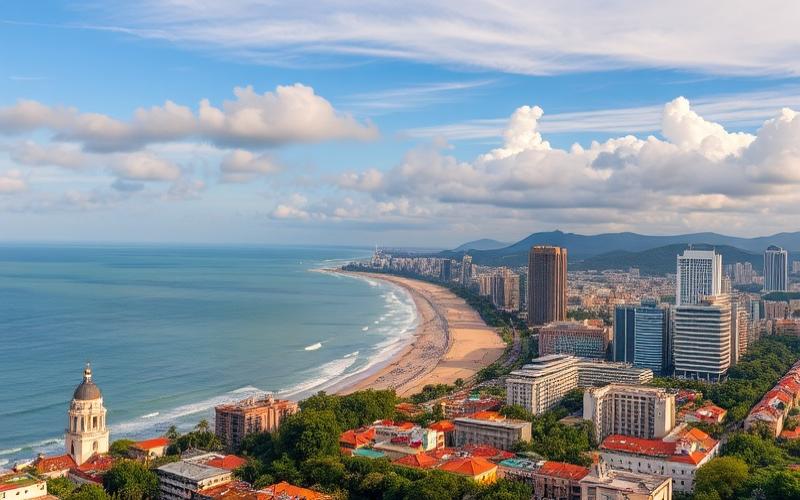
 Published on and written by Cyril Jarnias
Published on and written by Cyril Jarnias
Diving into Brazil’s local gastronomy is much more than a simple culinary journey; it’s a true sensory odyssey through a mosaic of flavors, colors, and traditions. For expatriates, discovering this rich and varied cuisine represents a unique opportunity to understand and appreciate Brazilian culture even more deeply.
This culinary guide is for those who wish to explore Rio’s vibrant markets, taste the savory feijoada, the deliciously melting pão de queijo, or savor the delicate fruity notes of açaí. Each dish, each flavor opens a window onto the country’s different regions, offering newcomers a rewarding chance to build authentic connections with this fascinating host country.
Introduction to Traditional Brazilian Cuisine
Traditional Brazilian cuisine stands out for its great diversity of ingredients and unique blending, reflecting the indigenous, African, and Portuguese influences that shaped the country’s history. This richness is expressed in the variety of dishes, culinary techniques, and flavors, where rice, beans, cassava, meats, fish, and tropical fruits hold a central place.
Main Cultural Influences:
- Indigenous: use of cassava, corn, freshwater fish, Amazonian herbs.
- African: introduction of palm oil (dendê), spices, fried preparations (e.g., acarajé).
- Portuguese: salted meats, cured meats, desserts based on milk, sugar, and eggs.
Key Ingredients:
- Rice and beans (often served together)
- Cassava (as flour, tapioca, or roots)
- Various meats (beef, pork, poultry)
- Fish and seafood, especially along the coasts
- Tropical fruits (mango, guava, açaí)
Some Iconic Dishes:
| Dish | Main Composition | Origin & History |
|---|---|---|
| Feijoada | Black bean stew, pork pieces (ears, sausage, tail), served with rice, collard greens, farofa, orange | Of Portuguese origin, this dish symbolizes conviviality; historically associated with enslaved people, it is now the national dish, consumed during family gatherings or celebrations. |
| Pão de queijo | Cheese bread made from cassava flour and cheese (usually Minas cheese) | Specialty from the state of Minas Gerais; the recipe comes from Portuguese colonial cuisine, adapted with local ingredients like cassava. |
| Acarajé | Ball of black-eyed pea dough, onion, salt, fried in dendê oil, often stuffed with dried shrimp, vatapá, salad | Dish of African origin, typical of Bahia, sold on the street by “baianas” dressed in white; linked to the religious traditions of Candomblé. |
Regional Diversity:
- North (Amazon): Use of cassava, river fish, tucupi (cassava broth), jambu (anesthetic herb). Examples: Tacacá, Pato no tucupi.
- Northeast (Bahia, Pernambuco): Spicy flavors, palm oil, coconut milk, seafood. Examples: Vatapá (cream based on bread, shrimp, coconut milk, dendê oil), Moqueca (fish or shrimp stew).
- Central-West: Dishes based on rice, meat, cassava, freshwater fish. Example: Arroz carreteiro (rice, dried meat).
- Southeast (Minas Gerais, São Paulo): Pork-based specialties, feijão tropeiro (sautéed beans), pão de queijo.
- South (Rio Grande do Sul, Santa Catarina): Churrasco tradition (barbecue), grilled meats on skewers, often enjoyed at large family gatherings.
| Region | Culinary Specialty | Cultural or Historical Anecdote |
|---|---|---|
| North | Tacacá, Pato no tucupi | Cuisine derived from indigenous peoples, lively markets in Belém. |
| Northeast | Vatapá, Acarajé, Moqueca | The baianas perpetuate Afro-Brazilian culinary rites. |
| Southeast | Feijão tropeiro, Pão de queijo | Minas Gerais celebrates rural cuisine and dairy products. |
| South | Churrasco | The “gaúchos” organize large outdoor churrascos, symbols of conviviality. |
Cultural Anecdotes for Immersion:
- Feijoada is traditionally served on Saturdays, bringing together family and friends around long tables.
- In Bahia, acarajé is sold on the street during religious festivals, sometimes accompanied by Candomblé songs and dances.
- The Southern churrasco is an opportunity for festive gatherings, where spit-roasting is a true art passed down from generation to generation.
- In the Amazon, tasting tacacá or fish with cassava allows one to discover ancestral flavors and share the daily life of river inhabitants.
For expatriates, exploring Brazilian cuisine means opening up to a mosaic of tastes and stories, where each dish tells a part of the local culture and invites conviviality, a central value of Brazilian society.
Good to Know:
Brazilian cuisine combines indigenous, African, and Portuguese influences, offering varied dishes like feijoada and acarajé, which differ by region, notably with vatapá from the Northeast and churrasco from the South. Be sure to try pão de queijo, a cheese bread originating from Minas Gerais, emblematic of Brazilian warm hospitality.
Food Markets: A Local Culinary Immersion
Food markets in Brazil are iconic places where the country’s cultural diversity is expressed and which play a central role in the daily life of the inhabitants. Since colonial times, markets have been shaped by the blending of indigenous traditions, African and European influences, giving rise to a rich and varied cuisine.
Main Markets to Visit:
| Market | City | Particularities |
|---|---|---|
| Mercado Municipal de São Paulo | São Paulo | Imposing architecture, immense variety of local and international products |
| Mercado Público de Porto Alegre | Porto Alegre | Friendly atmosphere, regional gaúcho specialties |
| Feira de São Joaquim | Salvador | Strong Afro-Brazilian influences, spices and exotic fruits |
In these markets, the atmosphere is unique: the aisles overflow with vibrant colors offered by stalls of tropical fruits like mango, passion fruit, or açaí. The scents mix those of freshly caught fish with the powerful smells of local spices such as Amazonian black pepper or cilantro. Warm voices are heard everywhere: vendors promoting their products with humor and popular music in the background.
Typically Sold Products:
- Exotic fruits (guava, pitanga)
- Fresh fish (Amazonian tilapia, shrimp)
- Meats (smoked pork for feijoada)
- Local spices (dendê used in Bahian moqueca)
- Traditional breads (pão de queijo)
The Afro-Brazilian influence is particularly evident in the sale of ingredients for acarajé or moqueca: bright red dendê oil imported from West Africa via enslaved Black people. Indigenous communities, in turn, bring grated cassava (“farofa”), rare tubers, and fish from the Amazon River.
Anecdotes about Brazilian Hospitality:
A vendor often offers a free tasting of an unknown fruit to foreign visitors. Merchants do not hesitate to tell the family story behind their stall or share a traditional recipe upon simple request – thus illustrating this world-renowned conviviality.
Practical Tips for Expatriates:
- Prefer visits early in the morning to get the best products.
- Prepare a few simple phrases in Portuguese (“Quanto custa?”, “Pode fazer desconto?”).
- Do not hesitate to negotiate gently – it’s accepted if done with respect.
- Observe before buying: taste if possible before any transaction.
Exploring a Brazilian market is much more than a culinary experience; it’s a lively dive into the social heart of the country.
Good to Know:
Brazilian food markets, like the Mercado Municipal de São Paulo, are a vibrant mix of colors and sounds where exotic fruits, fresh fish, and Afro-Brazilian spices fill the air with enchanting scents. To enjoy the vendors’ hospitality and get the best prices, visit early in the morning and don’t hesitate to negotiate.
Table Etiquette in Brazil: Tips for Expatriates
In Brazil, it is customary to wait for the host to start eating before touching your plate, especially during formal meals. This mark of respect emphasizes the host’s central place in Brazilian conviviality.
During lunches and dinners, it is common for toasts to be made with special drinks like cachaça or wine. Coffee (“cafézinho”) is often served at the end of the meal and constitutes an appreciated social ritual.
Conviviality and conversations are essential: warm and lively exchanges are an integral part of the meal. Light or personal discussions are encouraged, as they foster a relaxed atmosphere where everyone can actively participate.
To Avoid Any Faux Pas:
- Do not leave too much food on your plate: this can be interpreted as a lack of appreciation towards the cook.
- Always compliment the chef or host on the quality of the dish.
- Keep your wrists on the table but avoid resting your elbows on it.
- Never use your hands to eat (even for fruit), always prioritize knife and fork.
- Wait for the server to bring the bill if you are at a restaurant; asking hastily can be seen as rude.
Gestures to Avoid:
- Talking with your mouth full or making noise while eating.
- Using a toothpick without covering your mouth with a hand.
- Sitting at the head of the table without being invited; this place traditionally belongs to the head of the family or the host.
Sharing dishes is not as common as in Asia: everyone usually has their individual plate, but during large informal gatherings, it happens that people serve themselves directly from several large dishes placed in the center.
Here Are Some Practical Tips for Easy Integration:
Essential Rules for Integration
- Discreetly wait for the host to start before you
- Follow your neighbors regarding cutlery usage
- Systematically compliment the dishes served
- Participate in conversations whenever possible
- Politely accept any drink offered (or decline gently)
Summary Table:
| Behavior | To Do | To Avoid |
|---|---|---|
| Start of meal | Wait for the host | Eat before them |
| Toasts/drinks | Accept/participate | Refuse without valid reason |
| Conversations | Be warm/participative | Prolonged silence |
| Compliments | Praise the cook/host | Ignore/forget |
| Leftovers on plate | Finish reasonably | Leave a lot |
| Cutlery usage | Fork/knife even for fruit | Eating with fingers |
By adopting these local customs, one quickly shows a sincere willingness to share not only a meal but also an important part of Brazilian culture.
Good to Know:
Waiting for the host to start eating, raising your glass while saying “saúde” during toasts, and actively participating in conversations are essential; avoid leaving food on your plate and don’t forget to compliment the chef.
Exploring Iconic Restaurants and New Gastronomic Trends
A Casa do Porco, Maní, and D.O.M. are among Brazil’s iconic restaurants, each embodying a unique and influential approach to national gastronomy.
| Restaurant | Culinary Specialties | Influence on the Gastronomic Scene |
|---|---|---|
| A Casa do Porco | Cuisine centered on pork, from tartare to pancetta, including creations like pork cheek sushi, osso bucco with onion, and Porco San Zé (pork slow-roasted for 6 to 9 hours). Use of “nose-to-tail” and ingredients from their own farm. Accessible tasting menu, relaxed atmosphere. | Democratization of high gastronomy, valorization of terroir, international recognition (World’s 50 Best, Michelin green star). Pioneer of sustainability and creativity around an emblematic ingredient. |
| Maní | Contemporary Brazilian cuisine, reinvention of traditional dishes (moqueca, feijoada) using local ingredients, work on textures and contrasts. | Highlighting indigenous roots and Brazilian products, major influence on author cuisine and culinary innovation in São Paulo. |
| D.O.M. | Exploration of Amazonian biodiversity, use of rare ingredients (açaí berries, jambu, cupuaçu), refined interpretation of regional recipes. | Considered a global ambassador of Brazilian gastronomy, strong impact on the valorization of indigenous products and traditional know-how. |
New Gastronomic Trends in Brazil:
- Reinvention of Traditional Dishes: Many chefs are revisiting feijoada, moqueca, or tapioca with local, seasonal, and sometimes unexpected ingredients, like fermented cassava, Amazonian herbs, or alternative meats.
- Rise of Vegan Cuisine: Vegan versions of Brazilian classics are multiplying, incorporating products like heart of palm, black beans, and Brazil nuts, with vegetarian menus now present even in carnivorous institutions like A Casa do Porco.
- Impact of Expatriate Chefs: The arrival of foreign chefs brings new techniques, promotes flavor fusion, and energizes the local scene, especially in Rio and São Paulo, while encouraging the export of Brazilian cuisine internationally.
Growing Importance of Food Markets and Street Food:
- Markets like the Mercado Municipal de São Paulo are becoming hubs of culinary creation, where chefs and producers collaborate directly.
- Street food is enriched with innovative offerings (revisited pork sandwiches, stuffed tapiocas, gourmet açaí bowls) and attracts an ever-wider audience, promoting diversity and accessibility.
Use of Innovative Technologies in Modern Brazilian Kitchens:
- Integration of low-temperature cooking techniques, controlled fermentation, and use of 3D food printing for presentation.
- Supply chain tracking via digital tools to guarantee ingredient traceability and sustainability, as practiced by A Casa do Porco.
Expert Opinions and Enlightened Perspectives:
- International critics praise the balance between tradition and modernity, notably the ability of Brazilian chefs to “make high cuisine accessible without sacrificing creativity or quality.”
- The Michelin Guide, World’s 50 Best, and many experts consider that the Brazilian scene “is one of the most dynamic in the world, driven by a generation of committed and inventive chefs.”
- The evolution of Brazilian gastronomy is described as “an inspiring example of innovation rooted in respect for culinary heritage and biodiversity.”
Contemporary Brazilian cuisine combines respect for terroir, creativity, and openness to the world, making its flagship restaurants drivers of innovation and gastronomic democratization.
Good to Know:
A Casa do Porco is renowned for its inventive use of pork, Maní delights with contemporary dishes inspired by Brazilian heritage, while D.O.M. celebrates Amazonian ingredients; the Brazilian culinary scene is enriched by the rise of vegan cuisine and the reinvention of local classics, often revisited by expatriate chefs, with growing interest in street food and food markets.
Disclaimer: The information provided on this website is for informational purposes only and does not constitute financial, legal, or professional advice. We encourage you to consult qualified experts before making any investment, real estate, or expatriation decisions. Although we strive to maintain up-to-date and accurate information, we do not guarantee the completeness, accuracy, or timeliness of the proposed content. As investment and expatriation involve risks, we disclaim any liability for potential losses or damages arising from the use of this site. Your use of this site confirms your acceptance of these terms and your understanding of the associated risks.


























































